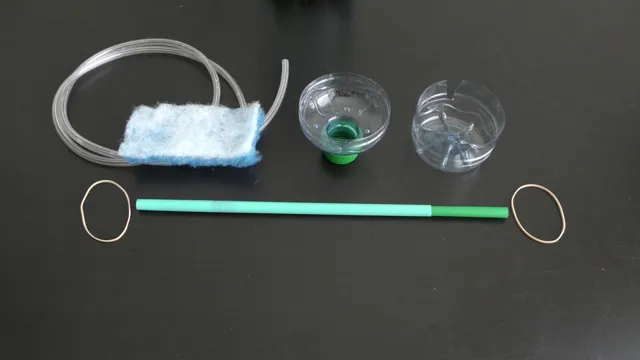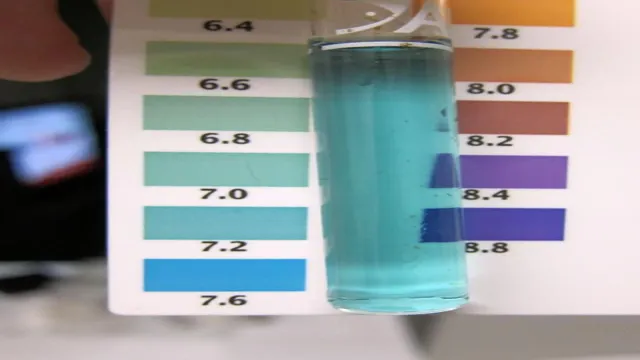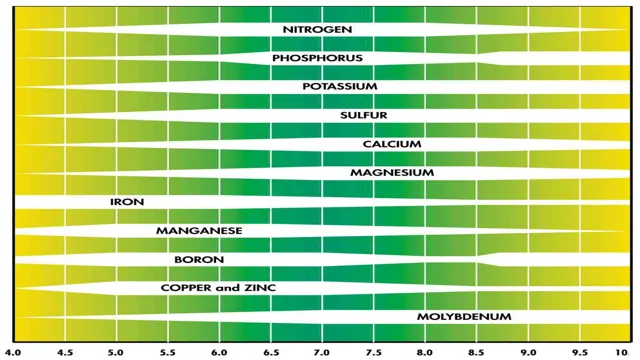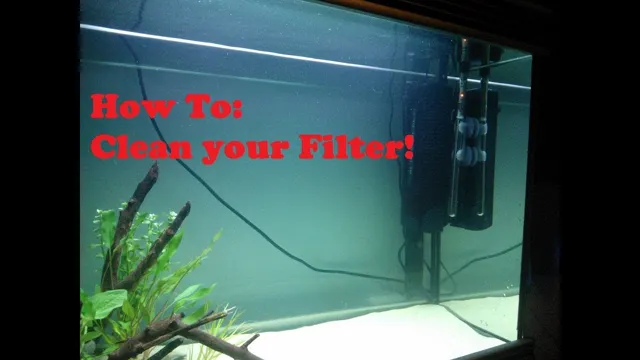Creating a DIY sponge filter is a great way to keep your aquarium clean and healthy for your fish. Not only is it cost-effective, but it also allows you to customize the filter to your specific tank needs. You don’t need any advanced skills or fancy equipment to put one together, making it an accessible project for any aquarium owner.
Plus, your fish will love the gentle water flow and soft sponge surface. So, are you ready to take on this exciting DIY project and improve your fish’s well-being? Let’s dive into the details of creating a DIY sponge filter.
Materials Needed
If you want to keep your aquarium clean, you need a good filtration system. One of the best types of filters is a sponge filter, which is easy to make at home. You will need a few materials to get started, such as a sponge, a plastic tube, an air pump, and an air stone.
The sponge should be able to fit inside the tube, leaving enough space for water to flow through. You will also need to cut the tube to the right size, so it fits inside your aquarium. Once you have all the materials, it’s time to assemble the sponge filter.
Insert the tube into the sponge, and attach the air stone to the end of the tube. Finally, attach the air pump to the other end of the tube, and turn it on. The air pump will push air through the tube and into the sponge, creating bubbles that will draw water through the sponge and filter out any debris or waste.
With a homemade sponge filter, you can keep your aquarium clean and healthy without breaking the bank.
Sponge material
When it comes to making sponges, one of the most crucial steps is choosing the right material. Here are the top materials needed to make a quality sponge: Foam – This is the most common material used for sponges.
It is soft, flexible, and absorbent, making it perfect for a range of cleaning tasks. Cellulose – This natural material is environmentally friendly and biodegradable.
It is great for absorbing liquids, making it perfect for wiping spills and messes. Microfiber – Microfiber sponges are increasingly popular as they are super absorbent and effective at cleaning.
Plus, they are non-abrasive and gentle on surfaces. Silicone – These sponges are long-lasting and great for scrubbing tough stains.
They are dishwasher safe and easy to sanitize, making them ideal for use in the kitchen or bathroom. So, whether you’re looking to clean your dishes, your countertops, or your floors, there’s a sponge material out there that’s perfect for the job. Choose the right one, and you’ll be able to tackle any cleaning task with ease!
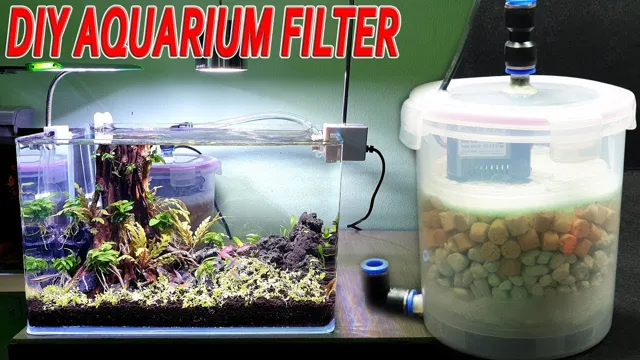
Airline tubing
Airline tubing is an essential component for aquarium hobbyists, as it is used to transport air from the air pump to various aquarium accessories, especially air stones and sponge filters. The material used to make airline tubing is usually non-toxic, soft plastic, giving it the flexibility to bend and shape into tight corners or hang over aquarium edges. The diameter of the tubing should match the air pump output size or the air stones being used.
Additionally, it’s necessary to use an airline check valve to prevent water from flowing back into the air pump, causing damage or failure. Other optional items that can be used with airline tubing include T connectors, Y connectors, and adjustable valves that regulate the amount of air going into the aquarium. Most importantly, it’s vital to replace airline tubing regularly to prevent any blockages, as old tubing can become brittle, resulting in air leaks.
Overall, airline tubing is an affordable and practical device for aquariums and is easy to set up and use for beginners and experienced hobbyists alike.
Air pump
When it comes to inflating items such as bicycle tires, footballs, or even air mattresses, an air pump can make the task significantly easier. But before you rush out to buy one, it’s important to consider the materials that come with it. Firstly, you’ll need the air pump itself; this can vary in size depending on what you plan on inflating and how often you’ll use it. (See Also: How to Do a Live Plant Aquarium: A Step-by-Step Guide to Creating a Thriving Aquatic Garden)
Secondly, you’ll need a nozzle or adaptor that fits the item you want to inflate – different items require different nozzles, so it’s important to check this before purchasing. Finally, some air pumps require a power source, whether that be batteries or an electrical outlet. It’s essential to choose a power source that meets the requirements of your particular air pump.
By ensuring you have all the necessary materials, you’ll be able to inflate a range of items quickly and easily. Keywords: air pump, materials, nozzle, adaptors, power source.
Check valve
A check valve is a handy device that helps regulate the flow of fluid in a pipeline system. Whether you’re dealing with gases or liquids, the check valve prevents backflow that could damage your equipment or cause a hazard. When it comes to choosing the right materials for your check valve, there are a few factors you should consider.
First, you need to think about the type of fluid you’ll be working with and whether it’s corrosive or abrasive. This will influence the choice of materials for the body, seats, and disc. Other factors to consider include temperature, pressure, and environmental conditions.
Some common materials used for check valves include stainless steel, brass, PVC, and Teflon. Ultimately, the goal is to find the right combination of materials that will provide the necessary performance and durability for your specific application. So take the time to research the options and consult with a professional if needed to ensure you find the best materials for your check valve.
Plastic bottle or PVC pipe
When it comes to DIY projects, choosing the right material is crucial to ensure the durability and longevity of your creation. If you’re torn between using a plastic bottle or PVC pipe, there are a few things you need to consider before making your decision. First, let’s talk about the materials you’ll need.
If you choose a plastic bottle, make sure it’s made of high-quality plastic that won’t easily break or tear. You’ll also need a sharp cutting tool, a hot glue gun, and any decorations or embellishments you want to add to your project. Alternatively, if you opt for a PVC pipe, make sure you choose a pipe that’s the right size for your project.
You’ll also need a saw or pipe cutter to cut the pipe to your desired length, PVC glue to attach any joints or fittings, and sandpaper to smooth out any rough edges. Now, let’s talk about some factors that can help you determine which material to use. If you’re looking for a water-resistant and sturdy material, a PVC pipe might be your best option.
However, if you’re working on a small-scale project and need a more flexible material that can be easily cut and manipulated, a plastic bottle might be more suitable. Ultimately, the decision between a plastic bottle and PVC pipe depends on your specific needs and preferences. Both materials have their benefits and drawbacks, so choose the one that aligns with your project goals and works best for you.
Assembly
If you are looking for a cost-effective way to keep your aquarium clean, then a sponge filter might be just what you need! These filters work by pulling water through a sponge, which traps debris and keeps it from circulating in the water. Making a sponge filter for your aquarium is relatively easy; you will need a sponge, a plastic container, an air pump, and some tubing. Begin by cutting a hole in the top of the container and threading the air tubing through it.
Cut your sponge to fit snugly inside the container, leaving a small gap at the top for water to flow through. Attach the tubing to the air pump and place the sponge filter in the aquarium. Turn on the air pump, and your filter will start working immediately! Not only are sponge filters inexpensive, but they are also easy to clean and maintain.
By using a sponge filter, you can keep your aquarium cleaner and your fish healthier. So why not give it a try today?
Cutting sponge material
Cutting sponge material can be a daunting task, but with assembly techniques, you can accomplish the job with ease. To make the process less overwhelming, it is essential to have the right tools and equipment on hand. A good quality cutter or blade is crucial for precision cutting, and a cutting mat provides added stability and protection for your work surface.
When cutting sponge, it’s important to take your time, especially if you are working with a large piece of material. Start by making small, shallow cuts, gradually increasing the depth until you have cut through the entire thickness. It’s also a good idea to practice cutting on a small sample piece before tackling a larger project. (See Also: How to Get Windows 10 Desktop Aquarium Background: DIY Guide for Creating a Stunning Underwater World)
With these assembly techniques, you can cut sponge material with confidence and precision, ensuring that your finished product looks professional and polished.
Preparing the air pump
When preparing your air pump for use, it’s vital to ensure that all the components are assembled correctly. Follow the instructions provided in the manual or tutorial video step-by-step to guarantee you don’t miss anything. Start by attaching the pump head to the base and the handle to the pump head securely.
Then, attach the hose and nozzle to the pump head, ensuring that there are no gaps or leaks. Additionally, check that the rubber gasket or seal ring is in place correctly, so no air can escape and keep the pump stable. Don’t be tempted to skip any sections of the assembly process, as this will hinder the air pump’s performance and may even cause damage.
Taking your time to assemble the air pump correctly will result in efficient and effective use.
Putting it all together
When it comes to assembling your final product, there are a few important steps to follow. First, make sure you have all the necessary parts and tools. Clear your workspace and lay out all the components, following the instructions carefully.
Begin by attaching the larger components together, then move on to the smaller details. Take your time and be patient as you work through each step. Once you have everything in place, give it a thorough inspection to ensure everything is secured and aligned properly.
Finally, test your product and make any necessary adjustments. Remember, taking the time to properly assemble your product will ensure a successful outcome.
Maintenance
If you’re looking for an affordable and effective way to keep your aquarium clean, a sponge filter is a great choice. Not only does it provide biological filtration, but it’s also easy to maintain and doesn’t require electricity. To make a sponge filter, all you need is a piece of airline tubing, a sponge, and an air pump.
Cut the airline tubing to a length that will reach from the air pump to the bottom of your aquarium. Attach one end of the tubing to the air pump and the other end to the sponge. Place the sponge in the tank and turn on the air pump, and your filter is ready to go! To maintain your sponge filter, simply rinse the sponge every few weeks to remove any debris that has accumulated.
With a little bit of maintenance, your sponge filter will keep your aquarium clean and your fish happy.
Cleaning the sponge filter
Keeping your sponge filter clean is important for the overall health of your aquarium. A dirty filter can lead to a decrease in water quality, which can in turn harm your fish and other aquatic animals. The good news is that cleaning the sponge filter is a relatively easy process.
First, remove the sponge from the filter by gently squeezing it and pulling it out. Then, rinse it thoroughly under running water to remove any debris. If the sponge is particularly dirty, you may need to clean it with aquarium-safe soap or bleach solution.
After cleaning, rinse the sponge again and let it dry completely before reinserting it back into the filter. It’s recommended to clean your sponge filter once a month to ensure optimal performance. By keeping your filter clean, you can help ensure that your aquarium stays healthy and thriving.
Replacing the sponge material
If you want to keep your cleaning tools in excellent condition, you must maintain them properly. It’s particularly true for sponges, which need some extra care to maintain their effectiveness. If your sponge material looks old or shows wear and tear, it’s time to replace it. (See Also: How to Polish Acrylic Aquarium: A Step-by-Step Guide to Crystal-Clear Viewing)
There are many ways to replace the sponge material, such as buying replacement sponges or making your own. When buying a replacement sponge, make sure to get the right size and material to maintain the overall quality of the tool. You can also make your own at home with some foam, a sharp blade, and some adhesive.
Just measure the sponge and the area where it needs to attach together and use the blade to make the correct shape. Then, apply adhesive to both sides and let it dry before attaching. With proper maintenance and timely replacement, you can keep your sponges clean and hygienic, and ensure they work effectively when you need them.
Conclusion
With a little creativity and some basic household items, you can save a splash of cash and make a sponge filter for your aquarium. By providing a cozy home for beneficial bacteria, your fish will be happier and healthier than ever before. So leave the expensive store-bought filters behind and dive into this fun and easy DIY project.
Your aquatic friends will thank you for it!”
FAQs
What is a sponge filter and how does it work in an aquarium?
A sponge filter is a type of biological filter that uses a sponge to trap debris and housing beneficial bacteria. As water passes through the sponge, the bacteria consumes harmful waste and toxins, promoting healthy and clean water for fish.
Can a sponge filter be used as the primary filter for an aquarium?
Yes, a sponge filter is an effective and efficient primary filter for aquariums up to 20-30 gallons. For larger tanks, it is recommended to use in combination with other types of filters.
What materials are needed to make a sponge filter for an aquarium?
To make a sponge filter, you will need a sponge, a plastic tube, an air pump, airline tubing, and a check valve.
How do you make a DIY sponge filter for an aquarium?
Cut a plastic tube to the desired length and attach a check valve at the end. Then, cut a sponge to fit over the tube and make a small hole in the center for the tube to fit through. Attach airline tubing to the air pump and connect it to the plastic tube. Finally, place the sponge filter into the aquarium and turn on the air pump.
How often should a sponge filter be cleaned?
It is recommended to clean the sponge filter once a month or as needed. Rinse the sponge in aquarium water to avoid killing beneficial bacteria.
Can a sponge filter be used in a saltwater aquarium?
Yes, a sponge filter can be used in a saltwater aquarium. However, it is not recommended as the primary filter and should be used in combination with other filtration methods.
How do you maintain a sponge filter for optimal performance?
To maintain a sponge filter, rinse the sponge regularly in aquarium water to remove debris and avoid clogging. Replace the sponge every 6-12 months to ensure the efficiency of the filter.

